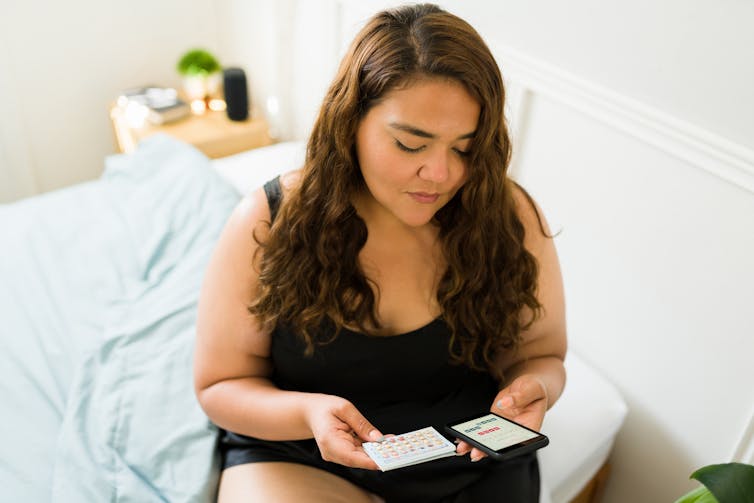
Singer and social media star Dixie D'Amelio revealed on Instagram recently that she has been diagnosed with premenstrual dysphoric disorder (PMDD). In her post, she shared how the condition left her feeling that she didn’t “want to be here anymore” and that she had never felt “so low”.
But although PMDD affects one in 20 women, very few people know about it. This means that many – just like D'Amelio – may suffer for years without knowing why they feel the way they do, and may not get the help they need. On average it takes 12 years before people receive a correct diagnosis.
What is PMDD?
Premenstural dysphoric disorder is a severe mood disorder, where people experience distressing and frightening psychological symptoms in the week or two before their period.

This article is part of Quarter Life, a series about issues affecting those of us in our twenties and thirties. From the challenges of beginning a career and taking care of our mental health, to the excitement of starting a family, adopting a pet or just making friends as an adult. The articles in this series explore the questions and bring answers as we navigate this turbulent period of life.
You may be interested in:
Should I post photos of my children online? Here’s what new parents need to know about sharenting
Four ways to support a friend or loved one with long COVID
Sunscreen: here’s why it’s an anti-ageing skincare essential
PMDD is not the same as PMS. They differ significantly in severity. Up to 80% of women experience PMS symptoms, which may cause both emotional and physical symptoms such as breast tenderness, bloating, weepiness or irritability. PMS symptoms are typically manageable and don’t impact severely on everyday life.
In contrast, PMDD has a debilitating impact on everyday life, and may even affect relationships, education and employment. While many of the physical symptoms are the same as PMS, people with PMDD will experience far more severe psychological symptoms. These include mood swings, a feeling of hopelessness, anxiety, irritability, feeling overwhelmed and difficulty concentrating.
Some people will first experience PMDD around the time their periods begin. But others may develop the condition later on, such as after pregnancy, or after they stop breastfeeding their child.
Although the causes of PMDD are not fully understood, ongoing research is exploring several possible mechanisms. These include genetic factors, long-term exposure to the hormone progesterone and one of the chemicals it breaks down into (allopregnanolone), an irregular relationship between the hormones oestrogen and serotonin, differences in brain structure and even past history of trauma.
How is it treated?
Most people with PMDD experience thoughts of self-harm and suicide. One in three people with PMDD will attempt to end their life. This is why it’s so important to increase awareness about the condition, so more people can get the help they need.
If you suspect you have PMDD it’s important to visit a GP to get a diagnosis. But before you do, you will want to track your menstrual cycle for at least two months. This is essential, as you will be able to show your doctor monthly patterns in your mood, and how this affects different aspects of your life. There are many apps you can use to help you do this, or you can record it in a journal.

PMDD is typically managed in a few different ways. The treatment plan you’re given may not be the same as the next person.
Many people will be given anti-depressants known as serotonin-selective reuptake inhibitors (SSRIs). These can work within hours to improve symptoms for people with PMDD. Although SSRIs can be taken everyday, they can also be taken only when symptoms return each month.
Another common treatment is prescribing hormonal contraceptives which prevent ovulation, such as the pill. This helps prevent the sharp changes in hormone levels which trigger PMDD episodes.
People who fail to respond to SSRIs or oral contraceptives may be given alternative treatments, such as GnRH analogues, which put women into a temporary artificial chemical menopause. The last-resort treatment for women who have not had success with other treatment options is oophrectomy, which surgically removes the ovaries.
What can you do?
It can be scary to learn you might have PMDD. But fortunately, there’s support out there. The International Association of Premenstrual Disorders, for example, has many excellent resources not only for you, but also your loved ones and health professionals. They provide information about PMDD and how you can manage it.
Peer support can also be a lifesaver. Knowing you have people to talk to about your experiences or who are going through the same thing can empower you and give you hope. Even if you don’t have friends who are going through something similar, there are moderated support forums, video support groups and social media platforms where you can find an online community of other people living with PMDD.
PMDD was only recognised as a medical condition in 2013, which is pretty recent in medical terms. This means there’s still a lot of work to be done in terms of improving diagnosis and treatment of the condition. This is something my own research aims to do.
Increasing awareness of PMDD is crucial in helping people access the right support, but also for educating health professionals on the symptoms and management options. But thanks to people like D'Amelio, PMDD is finally being talked about – which will hopefully lead to more people finally getting the help they need.
Lynsay Matthews receives funding from Research England and the Economic and Social Research Council to undertake PMDD research. Lynsay is affiliated with the Scottish Government as a member of their Cross Party Group on Women's Health.
This article was originally published on The Conversation. Read the original article.







